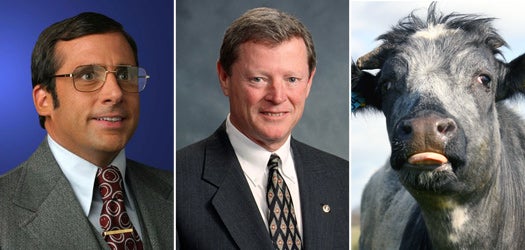Six Quiet Climate Villains
Under-the-radar polluters, and the individuals doing their best to hold climate science back

If you’re reading PopSci, you probably already know all about the latest efforts to offset carbon dioxide emissions, engineer clean building materials and combat pollution from traditional energy sources like coal and oil.
But you may be less aware of the more insidious climate villains–the quieter ones, which aren’t necessarily belching toxic gases or currently destroying the Gulf of Mexico. Their damage is more indirect, but that doesn’t make it less harmful.
A problem as immense as climate change stretches beyond the obvious. Did you know, for instance, that your TV weather man (or woman) likely doesn’t believe in climate change? Were you aware that the sirloin steak at your favorite chop house is a bigger contributor to global warming than your car?
Sure, we’ve made great strides in environmental protection since the days of burning rivers and the Crying Indian commercial. But it’s a heck of a lot warmer now. Most Americans still believe humans are to blame for this, but there are plenty of climate villains who are working to shift public opinion the other way.
Here are five of the worst:

The G20
The G20 and China
Plenty of people were responsible for the bungled opportunity that was the United Nations Climate Change Conference last winter. But the majority of the blame lies with the leaders of the world’s largest economic powers.
Developed nations should have formulated a meaningful agreement that would have actually led to reduced greenhouse gas emissions. Instead, their leaders politicked the conference to death and came away with a document that does little more than acknowledge climate change is a problem—something even George W. Bush was able to do almost 10 years ago. It was a flop, and it secured climate politics a spot on the back burner in many countries.
The world’s biggest economies must participate in international climate change agreements or they will be meaningless. The G20 group is responsible for more than three-fourths of the world’s pollution, so a 30 percent emission reduction in Lichtenstein isn’t going to help much if the big economic powers don’t clean things up. For instance, China, which emits more sulfur dioxide and carbon dioxide than any other nation, balked at provisions that would have required dramatic greenhouse-gas reductions.
Ultimately, the United States, China, India, Brazil and South Africa drafted the non-binding accord, excluding most UN members. Here’s hoping the next conference in Cancun later this year provides more inspiration than Copenhagen.
How to vanquish: At the voting booth

James Inhofe
James Inhofe
James “Mountain Jim” Inhofe might be proud to make this list — he’s one of the most vocal skeptics of global warming in the country. He’s compared the environmentalist movement to
the Third Reich and has called the threat of catastrophic climate change “the greatest hoax ever perpetrated on the American people.”
Though he lost his chairmanship of the Senate Environment and Public Works Committee when the Republicans lost the upper chamber, Inhofe can still do plenty of damage. One senator can do a lot to stop a carefully crafted climate bill (or any bill, for that matter), thanks to the byzantine rules of the Senate. This is important, given recent movement toward a climate vote sometime this summer.
On June 11, Democrats blocked a bill that would have prevented the EPA from regulating carbon dioxide emissions, which means the Obama administration might come up with emission regulations without any Senate action. But Democrats are still hoping for bipartisan climate legislation this year. Inhofe could employ various parliamentary tactics to grind things to a halt, if not derail them completely — such as placing a “hold,” which would require 60 votes to break, or offering countless amendments that would weaken the legislation.
Across the pond, Christopher Monckton, AKA Viscount Monckton of Brenchley, could fill Inhofe’s shoes. He’s been getting plenty of press lately for misrepresenting climate science in humorous, well-attended speeches in the United Kingdom (bad news when only 30 percent of Britons say climate change is “definitely” a real issue).
How to vanquish: Learn the facts so these politicians can’t fool you

Bjorn Lomborg
Pseudo-Academic Skeptics
Many climate-change skeptics put on an air of authority, masquerading as working members of the academic or scientific communities. But often, these naysayers will lack the specific qualifications or publications to back up their claims. The result is further public confusion and more fodder for deniers.
Danish professor Bjorn Lomborg is one of the best-known examples of this type of skeptic. In his controversial books “The Skeptical Environmentalist” and “Cool It,” Lomborg claims many of the most-publicized theses about global warming are wrong. He adds that there’s nothing to be done about it anyway, and that the world should refocus resources on solving problems like malaria, AIDS and malnutrition.
While those are admirable goals, it’s unrealistic to pit climate change against other issues in a zero-sum contest to decide the world’s worst problem. But the bottom line is that Lomborg is a political scientist, and he’s not qualified to contradict the work of climate scientists.
Social scientists are not the only villains, however.
“There are lot of other scientists who have credentials in science, but are quite ignorant in climate matters,” says Kevin Trenberth, head of the climate analysis department at the National Center for Atmospheric Research. “That gets into play in the war of words, and get used by various groups in different ways, and certainly that is a problem.”
Trenberth says Richard Lindzen, an MIT atmospheric physicist, is an especially prominent example. Among climate change skeptics, Lindzen’s credentials are hard to beat–he’s published more than 200 scientific papers, participated in the UN’s Intergovernmental Panel on Climate Change and is a member of the National Academy of Sciences. He published a paper earlier this year that claimed human-produced greenhouse gases will warm the world less than most climatologists claim.
Note that his paper says it will warm, just not as much as others predict. Despite that, deniers latched on to the paper as proof that climate scientists are hyping the evidence for warming. Trenberth and other climate scientists rebutted Lindzen’s findings on several grounds, including criticizing the team’s research methods. For his part, Lindzen said in an e-mail that he’s taken Trenberth et al’s criticisms to heart, re-done the study and his findings stand.
The point is, it’s an intricate, complex argument, and that complexity is usually lost in the public debate. In truth, most scientists who study climate–not geology, not economics, not atmospheric physics, but climate–accept that humans are contributing to global warming.
A study published in the January 2009 newsletter [PDF] of the American Geophysical Union asked 3,146 earth scientists whether they think human activity is “a significant contributing factor in changing mean global temperatures.” Among climatologists who actively publish research on climate change, 97.5 percent answered yes. But among scientists who were non-climatologists and didn’t publish research, only 77 percent said yes.
The findings suggest that as the level of research and specialization in climate science increases, so does agreement that humans are having an impact.
There are also plenty of scientists who do not dispute the fact that the climate has been warming — they simply disagree about why. Some suggest other causes like solar and cosmic rays or ocean currents. But studies [PDF] of those phenomena show they’re not nearly enough to account for all the warming.
For a nice list of scientific organizations endorsing the consensus that humans are causing climate change, go here.
How to vanquish: Read climate scientists, not pseudo-scientists

Brick Tamland
Your TV Weather Personality
There’s about a 50-50 chance he or she doesn’t believe in global warming. But that doesn’t mean he or she is qualified to tell you you’re wrong for being concerned–far from it. Even if your weather person is a trained meteorologist (only half of them are), meteorology is not climatology.
Climatologists study weather patterns over long periods of time. Meteorologists study weather patterns over a few days. Some forecasters scoff at the idea of climate scientists modeling the weather 100 years from now, when they can barely predict the weather next week. But they’re two different things.
Think of it this way: In Chicago next Monday, it looks like rain. That’s a weather prediction. In Denver in December, it will be cooler than it is today. No one can tell whether it will be sunny or snowing, but we can say, almost without a doubt, that it will be cooler. That’s a climate prediction.
That difference in perspective is a unique challenge for climate scientists like Trenberth.
“There’s so much going on that you can always cherry-pick a few things that look to be at odds,” he said. “You can convince somebody that there is no global warming, yet in the larger context there is a relatively straightforward explanation.”
More than half of Americans trust their weathercasters to tell them about global warming more than they trust other news media outlets or public figures like Al Gore or Sarah Palin, according to the New York Times. And in the same AGU study that polled physical scientists, only 64 percent of meteorologists agreed with the statement that humans are contributing to global warming.
Results of a survey by George Mason University’s Center for Climate Change Communication and the University of Texas-Austin are even worse: 27 percent of weathercasters surveyed believed that global warming was a scam. In another study by the same group, fewer than a third of meteorologists believed that climate change was “caused mostly by human activities.” And to top it off, about 90 percent of the weathercasters say they’ve lectured about climate change at Kiwanis Club-type speaking engagements.
Trenberth has given speeches to the weathercasters, and he’s taken to polling members of his audience before and after they see his presentation. The percentage of those who accept that humans are contributing to climate change usually increases once he puts down the PowerPoint clicker.
“Part of it does related to how open-minded people are to information. It’s the ones that are close-minded that are of course the biggest problem,” he says.
How to vanquish: If your local Brick Tamland starts talking about global warming, change the channel.

A cattle feedlot east of Greeley, Colorado
Big Beef
Consumers familiar with the term “locovore” know that learning the path your food took on its way to your plate is becoming more and more mainstream. But an often overlooked oart of that story is the fertilizer, oil, toxic gases and deforestation that played a more indirect but significant role in its production.
Livestock use 30 percent of the Earth’s entire land surface, according to a 2006 UN report, including 33 percent of the globe’s arable land. Huge swaths of the Amazon have been cleared to make way for feedlots and cattle grazing.
Land-use conversion is bad enough, but cattle production is also responsible for huge percentages of human-related greenhouse gas emissions, especially nitrous oxide, methane and ammonia, according to the UN study. Of the global methane that is induced by humans, cattle produce 37 percent of it.
Oil, coal and gas firms are obviously bigger villains, but that makes beef somewhat more insidious; it’s not often mentioned in the same breath as other huge polluters, so it’s harder to fight.
How to vanquish: Sous-vide some free-range chicken for dinner, with electricity provided by your backyard wind turbine.
You!
Well, OK, us. As a PopSci reader, you’re probably ahead of the curve — you’ve recycled your old laptop, read up on how to build an environmentally friendly dream house and you may even track your own energy usage.
But no matter how much you recycle or ride your bike, you–all of us, we Western consumers–are major contributors to global warming. Our love for gas-guzzling automobiles, cheap imported clothes and fun gadgets like iPads pegs us as all as climate villains.
From the dawn of the industrial age, our hunger for growth has been changing the environment. Probably the most famous example is the saga of the London peppered moth, a creature whose colors changed because of human-caused pollution.
Soot from London factories blackened the trees at the start of the Industrial Revolution, exposing the moths–which are naturally light-colored–to predators. Darker moths survived to pass on their genes, and eventually, London’s moths were predominantly black.
But there is a happy ending. With stricter environmental controls, the soot cleared up and lichens recovered, mottling London’s trees with pale green and white spots. And the light-colored moths returned.
So the good news is, things can change. And you, dear reader, can help.
How to vanquish: Fill up your reusable stainless steel water bottle and kick back with our Future of the Environment issue before using your iPad to order a new Nissan Leaf
